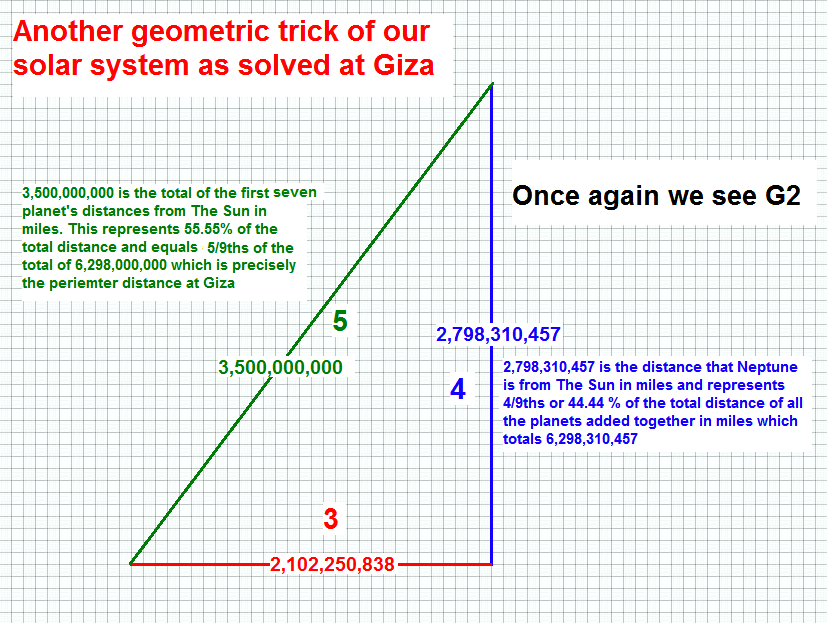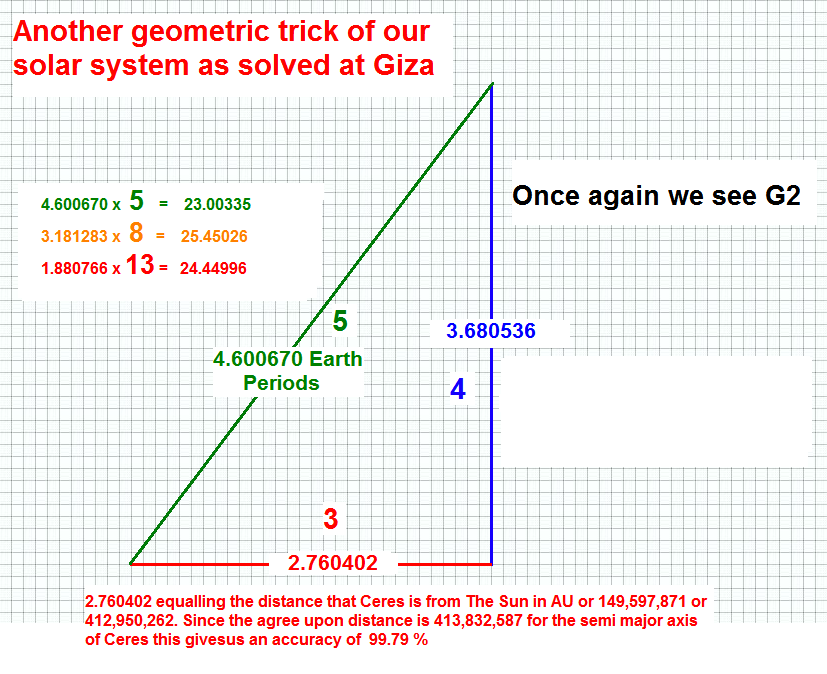As I continue to study the heavens (as above so below ? ) I marvel at the overall geometry that has been incorporated. Playing a major role as always are the gods Phi and Pi and also the sq root of 2 and possibly 3.
Please observe this one simple example of possibly hundreds but I have just begun my study but this is the one that immediately jumped out at me.
In the diagram below we have a 3, by 4, by 5 right angled triangle which is the building block of geometry and is the ratio of the sides of G2 the pyramid smack dab in the middle of The Giza Plateau. However instead of 3, 4 and 5 I have used 3,500,000 (miles) as our hypotenuse and equaling 5 units of 7,000,000 miles each. Surprisingly as our 4 unit side we have Neptune which is 4 x 7,000,000 miles or 2,800,000,000 miles (actual is 2,798,310,457 miles). This has far reaching ramifications for now when we look at G2 or Khafre's Pyramid we can say that not only does it represent Venus as we have shown many times and also The Sun (which will be for another post) but now we have shown that the height of G2, as in the diagram below, represents the distance to Neptune while the slope or hypotenuse is showing and represents the total distance of all the other seven remaining planets. However if you will remember from an earlier diagram the total distance of all the planets added together equaled the entire perimeter of The Giza Plateau and this has 9 + 11 + 9 + 11 or 40 units making up this 6,300,000,000 (actual 6,298,310,457 miles). This means that one of our 9 units here and at Khafre's Pyramid is equal to 4.444444 or 4 and 4/9th at Giza. There are nine units here simply 5 (3,500,000,000) + 4 (2,800,000,000) while there are 40 at Giza. 9 across then 11 down then 9 across again then 11 up. So we have amazingly the fact that the ratio of Khafre's Pyramid or G2 to the overall structure of the Giza plateau is equal to 4.444444 or 4 and 4/9th (9 to 40) while the height of this self same pyramid is defining the 44.44444 % point in the total distances of the entire solar system. I mean really, what are the odds ?

In this next diagram we visit this 3, 4 and 5 sided triangle again.The semi major axis of Ceres is about 2.76633 AU from The Sun and once again we will call on our favorite triangle to join in the dance. Please note here that the largest example of this triangle is situated smack dab in the middle of The Giza Plateau. It is of course the 3-4-5 right angled triangle and the pyramid is G2 or The Pyramid of Khafre. Now we have this:

We note that 3 in our triangle represents the distance from Ceres to The Sun in AU's and the 5 side is showing us the number of Earth periods in a rotation of Ceres.and further we note that the entire ballet seems to be playing in Phi - Pi time.
And now one last parting gift. The difference between the orbital period of Ceres at 4.600670 and the orbital period of Mars of 1.880766 in Earth periods is 2.719904 which I immediately recognized and so I simply multiplied by Phi and we get 4.4009 which is interestingly 1/100th of the base of The Great Pyramid in an orbital period to 100 cubit ratio and we note as well that the three ratios of 4.60067, 1.880766 and the synodic period of 3.181283 (synodic period of Mars - Ceres is 1162.4 days and divided by 365.256 we get 3.1824254770) all seem also to be playing in a Phi - Pi ballet of 5, 8 and 13 the Fibonacci number sequence.
This is all posted on a website (not mine) which I will link to a little later but I think it goes to show that such a beautiful ballet of celestial mechanics has been completely forgotten by the vast majority of humanity and what is even more tragic that like so much of the knowledge the ancients knew it is no longer taught at all. Very sad.

No comments:
Post a Comment